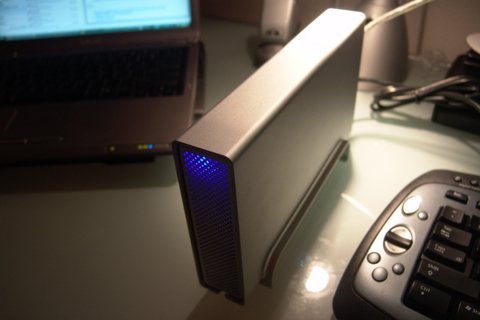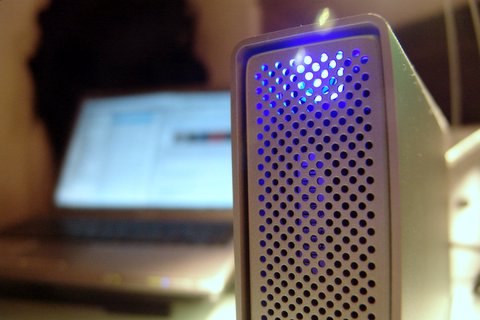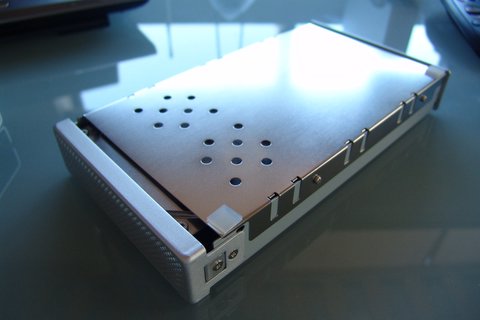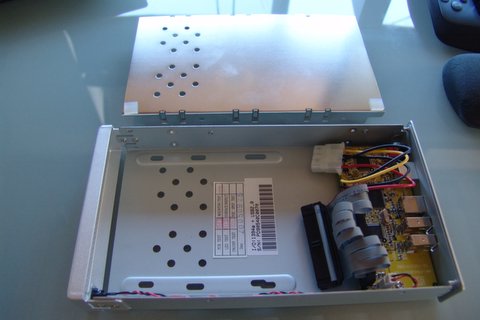Rosewill RX30-U2FA Ext. Enclosure

Introduction
In recent years, my storage needs have been growing at an alarming pace. It doesn’t help that all my current digital cameras are 8 megapixels or more and record MPEG-2 video at 30 frames per second and my collection of DV video is constantly growing. In addition to those storage hungry files, my home theater PC records analog cable and OTA (over the air) digital TV and HDTV broadcasts. These MPEG-2 based files can be gigantic in size, especially if they’re HDTV broadcasts. Trying to backup all of these files to paltry 4.7GB DVD-Rs takes a lot of time and often, collections of photos or related files don’t fit on a single disc.
Increasingly, I’ve found it much more practical to move files off to external hard drives. Storage is getting ridiculously cheap. As of today, one can get a 300GB hard disk for around $100 after rebates. Due to their low pricing, hard disk drives make for ideal backup units. All of the major hard disk manufacturers and third party companies have models available. However, I prefer to roll my own like my PCs for a variety of reasons.
First of all, most retail external hard disk units only come with a 1-year warranty. Tor me, this is unacceptable since the same bare retail drive may come with a 3 or 5-year warranty. Also, since people are using these units to store precious memories or documents it only makes sense that these things are built for a reasonable amount usage. The next issue is choice of interface. The standard interface of choice is good old USB2. You definitely want this interface for wide compatibility. However, I also prefer to have Firewire IEEE 1394 as well since it performs better than USB2 despite all of marketing hype. Also, not all units are built equally. USB2 and Firewire performance can suffer tremendously if they are using inferior or cheap supporting chipsets. When looking at Firewire chipsets you definitely want one that has an Oxford 911 or 922 chipset for guaranteed performance throughput. Lastly, a lot of units being sold are plain ugly and overpriced. It continues to boggle my mind with the amount of crappy, poorly designed products that are available on the market.
By putting together my own unit, I can have full control over the issues with existing external units. Also, in most cases, I end up saving a little money in the process and have something that works great and I’m not ashamed to put on my desk.
So, in my search for the ideal case, I came across a Rosewill RX-30 enclosure over at my favorite online store which seemed to have all the features I was looking for.
Rosewill RX30
The Rosewill RX30 series enclosures are based on Rosewill’s Pleiades 400+ enclosure which is most likely inspired by the Apple PowerMac G5 chassis design. Regardless, it’s a stylish, good-looking chassis.

The Rosewill RX30 actually comes in three different configurations at three different price points. They are the following:
RX30-U2 – USB 2.0 only with one USB type-B connection.
RX30-U2FA – USB 2.0 and Firewire IEEE 1394a with one USB type-B and two 6-pin Firewire 400 connections.
RX30-U2FAB – USB 2.0 and Firewire IEEE 1394b with one USB type-B, one 6-pin Firewire 400 and two 8-pin Firewire 800 connections.
Because all of my devices have Firewire 400 (aka IEEE 1394a), I chose the RX30-U2FA for my needs.
The basic specifications are:
- Bridge Chipset: Oxford 911 + Cypress AT2
- All aluminum enclosure
- IDE interface (PATA 3.5” Hard Disk drives only)
- Up to ATA-6 Support
- Plug and Play / Hot Swappable Connection
- Support for Windows XP/2K/ME/98SE and Mac OS 8.6 and higher
- 9.05” x 5.50” x 1.95” (22.8cm x 13.7cm x 3.5cm)
The package itself contains the following:
- RX30-U2FA Enclosure
- AC Adapter
- 1 x USB 2.0 Hi-Speed cable (Type-A to Type-B)
- 1 x Firewire 400 cable (6-pin to 6-pin)
- Mounting Stand
- Screw Package
- Manual and Driver CD
Build Quality
As mentioned previously, the RX30-U2FA took a design cue from the Apple PowerMac G5 with the grill in the front and the use of aluminum throughout. The design is sleek and unassuming with a nice “powdered aluminum finishâ€. All the screws are either hidden, on the back or the bottom of the enclosure to ensure a very clean look.


The most startling thing you’ll find with the enclosure is the weight. It’s hefty and as a result, the enclosure feels absolutely solid. The stand is well designed and has good balance. Although the enclosure can be used on its side, it seems that the optimal configuration is to have it vertically mounted. As a nice touch, the stand has rubber pads on all the feet so that your desk doesn’t get scratched.

The use of aluminum also allows the enclosure to be fanless so the only sound you’ll hear is the hard disk itself. If you’re using a quiet hard disk like a Seagate Barracuda then it’s pretty quiet indeed. The case itself acts as a heatsink to dissipate heat.
The port configuration on the back is pretty standard and what you would expect on these kinds of devices. The cut-outs are precise and everything is labeled very clearly.

I like the fact that it has an actual power switch on the back. I’ve seen enclosures without these and it baffles me. It may or may not be necessary but I like when it’s there. The power port is the DIN type. I’m actually not a big fan of these because in my experience, they tend to get loose over time and the power plug doesn’t stay in very well. So far, everything is fine but we’ll see how it does in the long term. It has come to my attention that Rosewill has changed the power plug recently to the “tip†kind that is more common.

Lastly, in the front of the device is an LED which glows blue to show you that the device is operational. It can also glow red if there is a over-voltage or under-voltage problem with the enclosure.
Installation
Installation is more or less easy. The major obstacle is the number of screws that must be removed in order to get to the inside of the enclosure. The stand itself has four screws that must be removed first before you can start removing the hard disk chassis.

Once the stand is removed, there are four more screws that hold the chassis in place. Upon removing the screws, you can slide the chassis out where you will find another four screws to remove chassis cover which shields the hard disk from the external part of the enclosure.

Once inside, you can see the internal IDE cable and power plug connected to the bridge board.

Upon examining the bridge board further you can see the Oxford 911+ chipset which is absolutely important if you’re going to be doing transfers over the Firewire connector.

Installing the hard disk is as easy as setting the hard disk to master, plugging in the IDE cable and power plug. With the included screws in the package, you mount the hard disk from the bottom of the chassis. Rosewill is nice enough to include “flat-head†screws so everything fits perfectly. Once complete, you reverse the process and put everything back.
All you need to do is plug it into your computer and initialize and format your new hard disk or simply start using it (if you’re using an existing hard disk) from your operating system.
Connectivity and Performance
It’s no surprise that the RX30-U2FA worked with every desktop computer, server and laptop via both the USB 2.0 and Firewire connections.
I actually ended up buying two of these devices and decided to test if the Firewire daisy chaining worked. For those that don’t know, the Firewire interface allows you to daisy-chain Firewire devices directly to each other without needing any sort of hub. That’s also one of the major reasons why I like Firewire over USB 2.0. I also had another existing Firewire/USB 2.0 enclosure that was tested with the pair of RX30s that I got.
During my testing, I actually came to a few alarming conclusions. There were a few situations where the Firewire daisy-chaining did not work! One drive would be recognized while the other wouldn’t. I ended up tracing the problem to a bad cable. So, beware of cheap cables. I ended up using the cables that came with the Rosewill enclosures and every worked fine. One other thing to remember is that both Firewire and USB 2.0 performance can be affected by the chipset used on the motherboard of the computer that you’re using with some implementations being better than others.
Although performance will vary depending on the type of hard disk you’re using in your enclosure, I ran a few informal tests using HD Tach 3 to see what kind of performance I was getting on the various types of connections. In my situation, I’m using a Seagate 7200.8 300GB 7200RPM 8MB Hard Disk drive.
The results are:

- Firewire 400 (Direct Connection) 41.5 MB/s, CPU utilization 4%
- USB 2.0 (Direct Connection) 32.9 MB/s, CPU utilization 22%
One thing to notice with graphs is that the Firewire connection is far smoother than the USB 2.0 connection. Not only is the performance higher but the CPU utilization is drastically lower. It just goes to show that USB 2.0’s theoretically faster 480Mbps bandwidth is marketing hype. The real issue is the CPU utilization rate. Firewire is simply a smarter interface. Furthermore, when daisy-chaining the enclosures together the daisy-chained enclosure’s performance was more or less the same as a directly connected enclosure with the same low CPU utilization.
Final Thoughts
Overall, I am quite happy with these new enclosures. They’re solid and they perform very well especially in the Firewire department which I use most of the time. It certainly helps that they’re very attractive looking and fit in nice with all the other stuff on my desk. With two of these each holding 300GB, it should satisfy my storage and backup needs for the time being.

I won’t lie. At around $65 per enclosure, the RX30-U2FA enclosures are more expensive than most of the ones you’ll see on the market. The RX30-U2FAB costs nearly $99 if you’re in need of Firewire 800 performance. However, I’m a firm believer in “you get what you pay for†and this enclosure does not disappoint in terms of performance, running virtually silent, and looking sharp on your desk. Also, if you’re shopping wisely then this enclosure plus a hard disk will still be cheaper than buying a comparable pre-packaged model. For instance, the Maxtor OneTouch 300GB external hard disk (with comparable USB 2.0 and Firewire 400 ports) costs around $220. At the current time of this article, it’s possible to get a Seagate 300GB hard disk for $89 (after rebates). Coupled with the $65 enclosure, that’s still a decent savings and the hard disk itself has a 5 year warranty on it. So, it’s something to consider when shopping around. Lastly, these enclosures also come in black now in case you’re not a fan of the silver aluminum color.
You can find more information about the product at Rosewill and can find a decent price for it at NewEgg.


